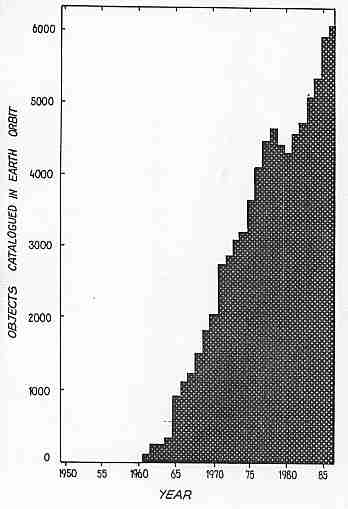The Solar Cycle and Orbital Space Debris
One benefit of a large solar cycle is to clear out some of the unwanted artificial space debris that is currently circling in low Earth orbit. At least 21,000 objects larger than 10 cm are orbiting Earth. Of these, only about 6 percent are operational satellites. The remainder are old satellites, rocket bodies, or other fragments. All of them pose a potential impact hazard to the operational spacecraft.
Ever since the start of the space age in 1957 (when Sputnik I was launched), the extent of space debris has increased to the point where there is now a real hazard to large operational structures such as space stations. The accompany graph show the increase in objects tracked and catalogued by NORAD each year for the first 3 decades of space operations.
Of interest here is the dip shown in the years 1979-80. This results from the increased atmospheric density at satellite altitudes around the time of the cycle 21 solar maximum. This increase was large enough to cause the rapid re-entry of many objects in the 200-400 km altitude range. This was the first time that the attrition rate of space 'junk' exceeded the generation rate from launch activity and fragmentation of existing objects in space. A similar and even more pronounced dip was produced at the maximum of solar cycle 22, around 1990.

Material prepared by John Kennewell





